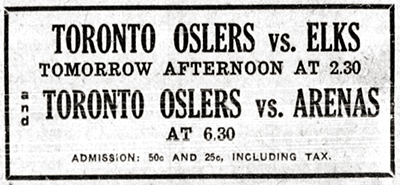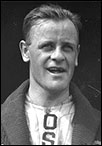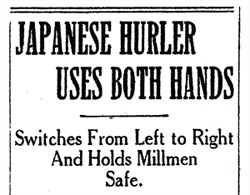The best team on the prairies in 1925 might well have been an outfit from Toronto, the famous Oslers. the defending Ontario amateur champions.

It was a short tour as the players couldn't get enough time off for a longer one. Up in Northern Ontario, in what we now call Thunder Bay, the Oslers kicked off with a 21-8 win, then a close one, 5-4 and then "Irish" Rasson fired a no-hitter as the Oslers romped 14-0.
 Due to a postponement, their first action in Winnipeg was a triple-header. More than 8,000 fans turned out for the July 1st event. Oslers won 5-0 (Joe Spring shutout), 9-3 and tied 7-7. They lost the next day 6-5, but followed with an 11-1 (Spring again) triumph and then a double-header which resulted in 3-0 and 10-1 (and again, Spring) victories over the top teams in the Manitoba capital.
Due to a postponement, their first action in Winnipeg was a triple-header. More than 8,000 fans turned out for the July 1st event. Oslers won 5-0 (Joe Spring shutout), 9-3 and tied 7-7. They lost the next day 6-5, but followed with an 11-1 (Spring again) triumph and then a double-header which resulted in 3-0 and 10-1 (and again, Spring) victories over the top teams in the Manitoba capital.

The best player on a prairie diamond that summer might have been American Negro League legend John Donaldson. He threw just a couple of games this side of the border but in the Moose Jaw Kiwanis Tournament fashioned a perfect game with 19 strikeouts.
The semi-pro teams from the southern part of Saskatchewan were heavily involved in tournament and exhibition action with their counterparts from Montana and North Dakota border towns during the summer of 1925 (see the game reports section for news on Donaldson, Swede Risberg and Happy Felsch) things were much different further north in the province.
Within the confines of Saskatoon, senior level baseball at the amateur level held the spotlight. After falling behind three games to none with one game tied in the Saskatoon City League playoffs, the Saskatoon C.N.R. team won four straight games from the Saskatoon  Elks to take the Hub City title and a berth in the provincial finals. Webb Bird, a transplanted Reginan, playing his second season (of three) in Saskatoon before returning to the Capital City, won the 1925 batting crown although his team, the Elks, failed in their attempt to cop the intra-city laurels. A 20-game hitting streak was among his accomplishments.
Elks to take the Hub City title and a berth in the provincial finals. Webb Bird, a transplanted Reginan, playing his second season (of three) in Saskatoon before returning to the Capital City, won the 1925 batting crown although his team, the Elks, failed in their attempt to cop the intra-city laurels. A 20-game hitting streak was among his accomplishments.
Expecting a playoff from Regina and Moose Jaw for 1925 amateur laurels, the Bridge City Railroaders, instead, backed into the provincial senior title when neither of the southerners put forth a challenge. The August 28, 1925 edition of the Saskatoon Phoenix suggested that Regina and Moose Jaw were far more interested in tournament and exhibition commitments to the inevitable neglect of their respective city league schedules and that several players, not quite good enough for all-star company, were forced into comparative idleness.
In the Regina Northside League in late May, the Champs out hit Darke's Hardware by just 13-11 but ran away with an 18-4 victory. Darke's made a dozen errors, gave up 15 stolen bases, three passed balls, two wild pitches and walked nine batters.
Also in the Northside loop, 17-year-old Athol Young got a chance to play with the big boys and went on to stun his elder teammates with a sterling season. He picked up a win in relief in that first game, then proceeded to rip off seven consecutive complete game victories to finish the season at 8-0.
 Outfielder Mel Kerr became the first Saskatchewan player to reach the major leagues.
Outfielder Mel Kerr became the first Saskatchewan player to reach the major leagues.
Born in Souris, Manitoba, Kerr grew up in Saskatoon and became one of the province's most outstanding all-round athletes.
After leading the Saskatoon City League in hitting in 1924, with a .429 average, Kerr was signed by the Chicago Cubs and was a September call-up. He played in just one game, as a pinch-runner and scored a run.
Kerr had a solid minor league career ended by a shoulder injury in the early 1930s.
In 1925, the main diamond for baseball in Calgary was Mewata Park and over 3,500 fans crammed into the facility for the opening game.
That's why they play the games. The pitching match up July 24th was lefty Bill Mulholland of the Calgary Athletics, loser of five straight starts, against Bill Walker, of the Calgary White Sox, with eight consecutive complete game victories, including a no-hitter. Yep, Mullholland tossed a shutout as the Athletics won 3-0.
 A teenager (who would become both a hockey and baseball star) put on quite the show in the kickoff to the 1925 Southern Alberta League. 18-year-old LeRoy Goldsworthy fired a one-hitter with 13 strikeouts in a six inning contest. Already, this was his third season in senior ball.
A teenager (who would become both a hockey and baseball star) put on quite the show in the kickoff to the 1925 Southern Alberta League. 18-year-old LeRoy Goldsworthy fired a one-hitter with 13 strikeouts in a six inning contest. Already, this was his third season in senior ball.
In mid-June, pitching for New Dayton in the Southern Alberta loop, Billy Eagleson scattered eight hits to claim the mound triumph. But, it was what he did with the bat which drew the headlines. In one of his turns at the plate, Eagleson fouled off 17 pitches before clouting a solid single.
In junior ball, left-hander Wilf Pennington, a 19-year-old, hurled five games in five days, four complete game starts and a relief effort to rack up three wins and a tie for the Medicine Hat Typos.
The 1925 edition of Winnipeg's Sherburn Park League received a cool reception. On opening day, blowing snow was felt throughout the game but the Crescents and Tigers went nine inning nonetheless.
When you're not the pitcher this could be fun. In the Wesley Park League in mid-May, the Columbus Club and Tammany Tigers combined for 27 hits, ten walks, two hit batters and 14 errors in a 14-11 contest. Both starting pitchers went the distance.
A highlight for a reliever. May 20th, Ole Olien of the Elks took over in the seventh inning with the bases loaded and none out. He ended the ending striking out the side.
 At the end of May, veteran Doc Flanagan, the dentist, came out for his first game of the season. You wonder what he could have done with a little practice. Flanagan crushed a pair of home runs and two singles then drew a walk to score the winning run for Columbus Club. He went on to win the batting title.
At the end of May, veteran Doc Flanagan, the dentist, came out for his first game of the season. You wonder what he could have done with a little practice. Flanagan crushed a pair of home runs and two singles then drew a walk to score the winning run for Columbus Club. He went on to win the batting title.
An unusual triple play highlighted a June contest between the Tammany Tigers and the Elks. With Tony Baril perched on second base and Bill Cockburn on first, Gord McKenzie poled a sizzler that was snared by first sacker Olie Olien who then stepped on the bag to double Cockburn. Before Baril had a chance to retreat and touch the keystone sack on the line-out, Olien whipped the ball in the direction of second base but miscalculated the range as the horsehide sailed into the left pasture. Forgetting the formality of first touching second base, Baril broke for third base where he was later called out after the orb had been retrieved and relayed back to the keystone station.
Winnipeg's Columbus Club had a pitcher named Pitcher. Records indicated he appeared in just one game.
The Vancouver Senior League had the most successful opening in the history of amateur baseball in the city as some 3,000 people crowded into Athletic Park for a season-opening double-header.
 New city, same result. Haley Jackson, (left) leading hitter in the Victoria Senior League in 1924, topped all the hitters in the Vancouver Senior Amateur League in 1925. Jackson finished with a .419 average.
New city, same result. Haley Jackson, (left) leading hitter in the Victoria Senior League in 1924, topped all the hitters in the Vancouver Senior Amateur League in 1925. Jackson finished with a .419 average.
In the Vancouver Twilight League, a pitcher won the batting title for the second straight season. Lefty Hunter topped the field with a .474 mark.
The Fraser Cafe baseball club of New Westminster captured the B. C. Senior A championship defeating Victoria CPR and then topped Fernie (representing Alberta) in an interprovincial series.
A tragedy was among the stories from British Columbia as a Wycliffe player died after being hit on the head in a pre-game accident in mid-July.
Damon Foster, an infielder with the local team died in hospital from injuries received when struck on the head during batting practice and fielding practice before the scheduled game with Wardner. While stooping to pick up a bat he was struck by another bat that flew from the hands of teammate Ingie Johren who was hitting fly balls to the outfielders.. He was 42. Foster, from Iowa, was recognized as one of the best all-around athletes to graduate from Davenport high school. He was a member of the track, football, basketball and baseball teams.

In baseball, one of the rarest feats is having an ambidextrous hurler -- both a righty and a southpaw!
In 1925 there was word of one, playing for a feeder club for the famous Asahis of Vancouver. G. Sarayama attracted the notice of the local paper, the Vancouver World, as he pitched the Mikados to a 10-4 victory over Hanburys in Senior B action at McBride Park on May 13, 1925. Sarayama was the centre of interest as he pitched with his left hand for the first three innings and before the fourth, warmed up with his right. When Stan Clark knocked a two-bagger on a lefty delivery, Sarayama changed hands and allowed only one hit the rest of the game. In the seven-inning contest, he allowed seven hits, fanned six and walked a pair.
